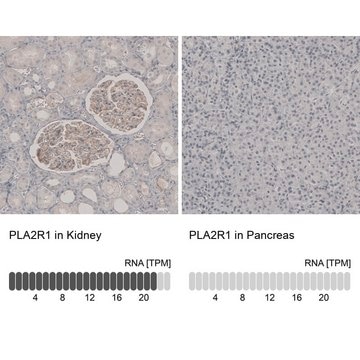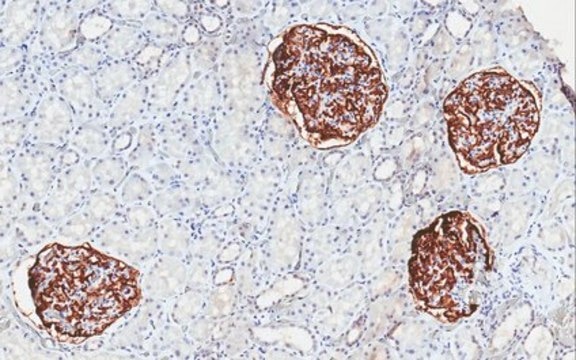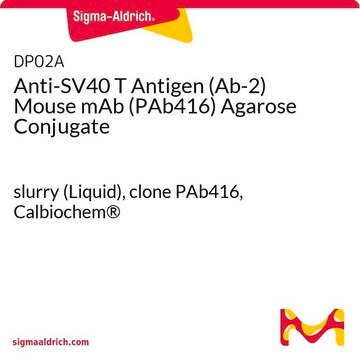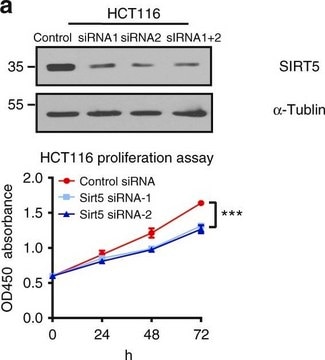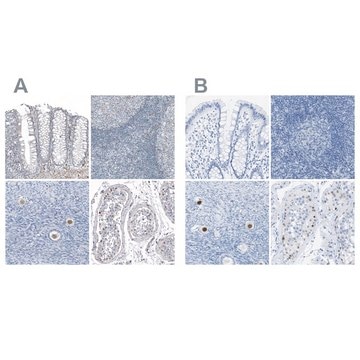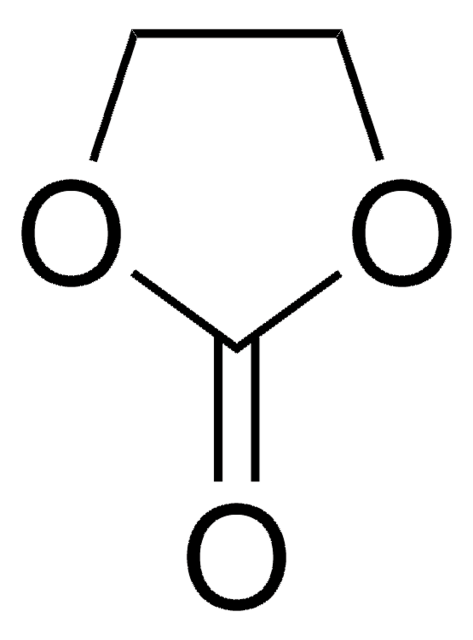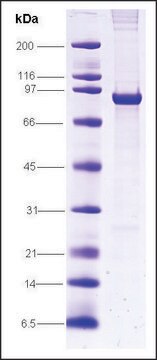DP02
Anti-SV40 T Antigen (Ab-2) Mouse mAb (PAb416)
liquid, clone PAb416, Calbiochem®
Sign Into View Organizational & Contract Pricing
All Photos(1)
About This Item
UNSPSC Code:
12352203
NACRES:
NA.41
Recommended Products
biological source
mouse
Quality Level
antibody form
purified antibody
antibody product type
primary antibodies
clone
PAb416, monoclonal
form
liquid
contains
≤0.1% sodium azide as preservative
species reactivity
SV40-infected cells
manufacturer/tradename
Calbiochem®
storage condition
do not freeze
isotype
IgG2a
shipped in
wet ice
storage temp.
2-8°C
target post-translational modification
unmodified
General description
Purified mouse monoclonal antibody generated by immunizing mice with the specified immunogen and fusing splenocytes with NS-1 mouse myeloma cells (see application references). Recognizes the ~94 kDa SV40 large T antigen.
Recognizes ~94 kDa SV40 large T antigen in SV80 and SV-T2 cells.
SV40 T Ag (Ab-2) is a mouse monoclonal antibody with specificity for antigenic determinants unique to the SV40 large T antigen and non-reactive with SV40 small T antigen. Both antigens are encoded by the early region of the SV40 genome. The large T antigen binds DNA, and complexes with a 53,000 dalton cellular transforming protein, p53, which is required for initiation of viral DNA replication during lytic growth. In addition the large T antigen binds DNA polymerase and the transcription factor AP-2 and forms a specific complex with the p105 product of the retinoblastoma susceptibility gene.
This Anti-SV40 T Antigen (Ab-2) Mouse mAb (PAb416) is validated for use in Affinity Purification, Immunoblotting, IF, IP, Paraffin Sections for the detection of SV40 T Antigen (Ab-2).
Immunogen
Epitope: Within amino acids 83-128
purified SV40 large T-antigen
Application
Affinity Purification (use Cat. No. DP02A)
Immunoblotting (1-5 µg/ml, see application references)
Immunofluorescence (1-5 µg/ml)
Immunoprecipitation (1-5 µg antibody, use Cat. No. DP02A)
Paraffin Sections (see application references)
Immunoblotting (1-5 µg/ml, see application references)
Immunofluorescence (1-5 µg/ml)
Immunoprecipitation (1-5 µg antibody, use Cat. No. DP02A)
Paraffin Sections (see application references)
Packaging
Please refer to vial label for lot-specific concentration.
Warning
Toxicity: Standard Handling (A)
Physical form
In 50 mM sodium phosphate buffer, 0.2% gelatin, pH 7.5.
Analysis Note
Negative Control
3T3 cells
3T3 cells
Positive Control
SV80 or SV-T2 cells
SV80 or SV-T2 cells
Other Notes
DeCaprio, J.A., et al. 1988. Cell54, 275.
Whyte, P., et al. 1988. Nature334, 124.
Mitchell, P.J., et al. 1987. Cell50, 847.
Dixon, R.A.F. and Nathans, D., 1985. J. Virol.53, 1001.
Simanis, V. and Lane, D.P. 1985. Virol.144, 88.
Mann, R.S. and Carroll, R.B. 1984. Virology138, 379.
Sarnow, P., et al. 1982. Cell28, 387.
Crawford, L.V., et al. 1981. Proc. Natl. Acad. Sci. USA78, 41.
Lane, D.P. and Crawford, L.V. 1979. Nature278, 261.
Carroll, R.B., et al. 1974. Proc. Natl. Acad. Sci. USA71, 3754.
Tooze, J. 1973. Cold Spring Harbor, New York.
Tegtmeyer, P. 1972. J. Virol.10, 591.
Whyte, P., et al. 1988. Nature334, 124.
Mitchell, P.J., et al. 1987. Cell50, 847.
Dixon, R.A.F. and Nathans, D., 1985. J. Virol.53, 1001.
Simanis, V. and Lane, D.P. 1985. Virol.144, 88.
Mann, R.S. and Carroll, R.B. 1984. Virology138, 379.
Sarnow, P., et al. 1982. Cell28, 387.
Crawford, L.V., et al. 1981. Proc. Natl. Acad. Sci. USA78, 41.
Lane, D.P. and Crawford, L.V. 1979. Nature278, 261.
Carroll, R.B., et al. 1974. Proc. Natl. Acad. Sci. USA71, 3754.
Tooze, J. 1973. Cold Spring Harbor, New York.
Tegtmeyer, P. 1972. J. Virol.10, 591.
The agarose conjugate (Cat. No. DP02A) is also available and suitable for affinity purification and immunoprecipitation. Antibody should be titrated for optimal results in individual systems.
Legal Information
CALBIOCHEM is a registered trademark of Merck KGaA, Darmstadt, Germany
Not finding the right product?
Try our Product Selector Tool.
wgk_germany
WGK 2
flash_point_f
Not applicable
flash_point_c
Not applicable
Certificates of Analysis (COA)
Search for Certificates of Analysis (COA) by entering the products Lot/Batch Number. Lot and Batch Numbers can be found on a product’s label following the words ‘Lot’ or ‘Batch’.
Already Own This Product?
Find documentation for the products that you have recently purchased in the Document Library.
Archives of pathology & laboratory medicine, 142(9), e2-e202 (2018-09-13)
and case study poster sessions will be conducted during the 2018 College of American Pathologists Annual Meeting (CAP18), which is scheduled for October 20 to 24, 2018. The meeting will take place at the Hyatt Regency, Chicago, Illinois. The poster
Tobias May et al.
Methods in molecular medicine, 140, 1-15 (2007-12-19)
Cell therapies rely on the implantation of well-characterized functional cells with defined properties. Often, the cells of interest do not proliferate in vitro and thus cannot be expanded to the amount needed for characterization, purification, manipulation, or cloning. Here, we
B K Kleinschmidt-DeMasters et al.
Journal of neuropathology and experimental neurology, 71(7), 604-617 (2012-06-20)
The use of natalizumab to treat multiple sclerosis (MS) has been associated with the development of progressive multifocal leukoencephalopathy (PML), with 242 PML cases reported as of May 3, 2012. Fortunately, rapid withdrawal of the drug and administration of plasma
V Krump-Konvalinkova et al.
Laboratory investigation; a journal of technical methods and pathology, 81(12), 1717-1727 (2001-12-14)
The limited lifespan of human microvascular endothelial cells in cell culture represents a major obstacle for the study of microvascular pathobiology. To date, no endothelial cell line is available that demonstrates all of the fundamental characteristics of microvascular endothelial cells.
S Bialasiewicz et al.
Transplant infectious disease : an official journal of the Transplantation Society, 15(3), 283-289 (2013-04-05)
BK virus (BKV) is an ubiquitous human polyomavirus that establishes latency in urothelium. BKV is known to re-activate in immunosuppressed individuals, and is an increasingly important cause of nephropathy and graft loss in kidney transplant recipients. Animal studies have demonstrated
Our team of scientists has experience in all areas of research including Life Science, Material Science, Chemical Synthesis, Chromatography, Analytical and many others.
Contact Technical Service